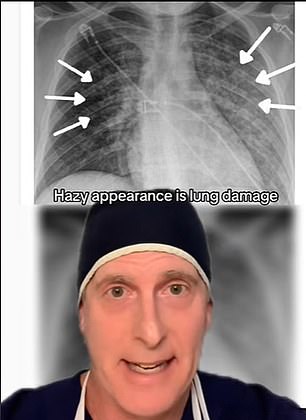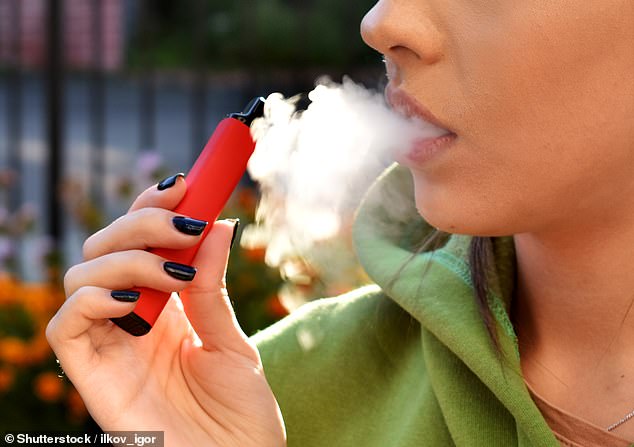I’m a doctor – this is why I believe vaping is much worse than smoking cigarettes: ‘It barbeques your lungs!’
A doctor has warned that vaping ‘barbecues your lungs’ and increases the risk of lung transplants in young people.
Dr. Brian Boxer Wachler, an eye surgeon in Beverly Hills, California, took to TikTok last week to explain why vaping is more dangerous than smoking cigarettes.
“The temperatures of vapors can be significantly higher than cigarette smoke, so vaping can literally barbecue your lungs,” he said in the video, which has been viewed 6.3 million times. “(This could) explain why more younger people who vape need lung transplants than younger people who smoke cigarettes.”
The majority of doctors still say vaping is safer than cigarettes, which have been unequivocally linked to cancer and release thousands of known deadly chemicals.
But a growing body of research suggests that vaping also poses serious long-term health risks, especially to the lungs and heart.

Dr. Brian Boxer Wachler, an eye surgeon in Beverly Hills, California, took to TikTok last week to explain why vaping is more dangerous than smoking cigarettes. “The temperatures of vapors can be significantly higher than cigarette smoke, so vaping can literally barbecue your lungs,” he said in the video, which has been viewed 6.3 million times.

Federal data shows that about 14 percent – more than 2.5 million – of American youth in sixth through twelfth grade vape, while another study found that one in twenty American adults vape. That compares to only one in ten tobacco smokers
Earlier this year, the American Heart Association (AHA) warned that the cocktail of nicotine, thickeners, solvents and flavorings in vape devices pose greater risks to heart health than smoking cigarettes.
Long-term exposure to diacetyl and acetylpropionyl, two flavoring chemicals, has been linked to shortness of breath, chronic cough, asthma and congested airways.
Experts have also warned against second-hand vaping.
Scientists from universities in Virginia and North Carolina reported that when e-cigarette users puffed in their cars for less than 10 minutes, the air around them became loaded with potentially toxic particles known specifically as PM2.5 (which indicates a diameter of 2.5 micrometers or smaller).
PM2.5 can be generated from natural and man-made sources, such as the combustion of fossil fuels. When inhaled, the substance enters the lungs and irritates the entire respiratory system, possibly causing or aggravating asthma, bronchitis and severe wheezing.
The matter is so small that it can enter the bloodstream, leading to system-wide inflammation that increases risk to cardiovascular health.
Vapes without nicotine can also lead to “e-cigarette, or vaping, product use associated with lung injury,” or EVALI.
The exact cause of the injury is still not fully understood, but researchers have since focused on the compound vitamin E acetate, which is often used as a thickener in illegal cannabis vape devices.
Dr. Boxer Wachler pointed to a 2022 study published in the journal Critical reviews in toxicologywhich found that of 11,350 patients with lung damage from vaping, half vaped both nicotine and THC, the ingredient in cannabis that gives users a ‘high’.
However, more than a third of patients vaped only THC, while 17 percent vaped nicotine.
“Lung damage can occur with any form of vaping,” said Dr. Boxer Wachler.
‘Please don’t vape.’
There is no test to determine if someone has EVALI, so the diagnosis is based on symptoms, including shortness of breath, fever, chills, cough, vomiting, diarrhea, headache, dizziness, fast heart rate and chest pain, according to the American Pulmonary Association (ALA).
EVALI has caused a number of distressing health problems. A 34-year-old Ohio woman who consumed about eight cartridges of vape liquid every week, the equivalent of 50 cigarettes a day, found herself on life support within 24 hours of going to the emergency room for breathing problems.
In another terrifying case, a 20-year-old woman from Britain named Abby Flynn developed a rare lung condition called ‘popcorn lung’ that doctors warned could leave her dependent on an oxygen machine before the age of 30.
Federal data shows that about 14 percent — more than 2.5 million — of U.S. youth in sixth through 12th grades vape, while another study reported one in 20 American adults vape. That compares to only one in ten tobacco smokers.
